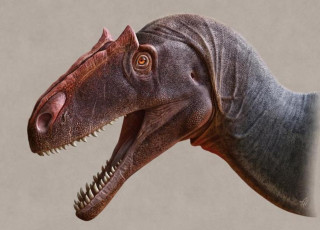The Fossil Record of Dino-Sores
By Riley Black
Dinosaurs didn't have it easy. Even though the "terrible lizards" often seem invulnerable in our imaginations, the truth is that dinosaurs suffered from many of the maladies that we do. Dinosaurs got cancer. Dinosaurs had to fend off bug bites. And sometimes dinosaurs broke their bones.
The Natural History Museum of Utah has its fair share of busted dinosaur bones. In the Museum's Cleveland-Lloyd Dinosaur Quarry exhibit, for example, you might spot some infected Allosaurus toe bones. Precisely how the dinosaur's toe became infected isn't clear, but somehow a break or other injury led to a terrible infection that caused the dinosaur's bone tissue to grow in a strange way and look very lumpy compared to a healthy bone. The infection, to experts, is called a pathology - a deviation from what paleontologists expect of healthy tissue.
There are other injuries in the Museum's fossil collection, too. Sometimes these bones might tell us a little something about the lives of dinosaurs that lived millions upon millions of years ago. In the Museum's collections, for example, there is the lower leg bone of a tyrannosaur. This bone was broken while the animal was alive - paleontologists know this because the fossilized bone shows signs of healing. That tells experts that the bone was broken when the animal was alive and was repairing itself when the dinosaur perished.
An even older, Jurassic fossil tells a similar story. Among the many, many thousands of bones from the Cleveland-Lloyd Dinosaur quarry, there is a peculiar Allosaurus vertebra with a strange divot in it. The bone was injured while the carnivore was alive and the bone tissue was healing when it died. What caused the petrified pockmark? One contender is the tail spike of a Steogsaurus. These armored dinosaurs had a set of four long, conical spikes at the ends of their tails and could swing them with surprising speed. Perhaps the injured Allosaurus was looking for lunch and got a little more than it bargained for from their potential prey.
Many of the injuries dinosaurs had to deal with are familiar to us. That's because many of these bony injuries come with having a skeleton, from infections to fractures. Sometimes they can tell us a story, such as a carnivore's failed hunt. Other times they can tell paleontologists something about what populations of dinosaurs had to cope with. Many predatory dinosaurs, for example, have a greater number of broken and injured bones than herbivores. Even though we might think of tyrannosaurs or allosaurs as being perfectly-adapted predators, they often made mistakes or missteps that became recorded in their very bones.
This post is presented as part of the 2021 Behind the Scenes Reimagined series.
Riley Black is the author of Skeleton Keys, My Beloved Brontosaurus, Prehistoric Predators, and a science writer for the Natural History Museum of Utah, a part of the University of Utah in Salt Lake City. Our mission is to illuminate the natural world and the place of humans within it. In addition to housing outstanding exhibits for the public, NHMU is a research museum. Learn more.


